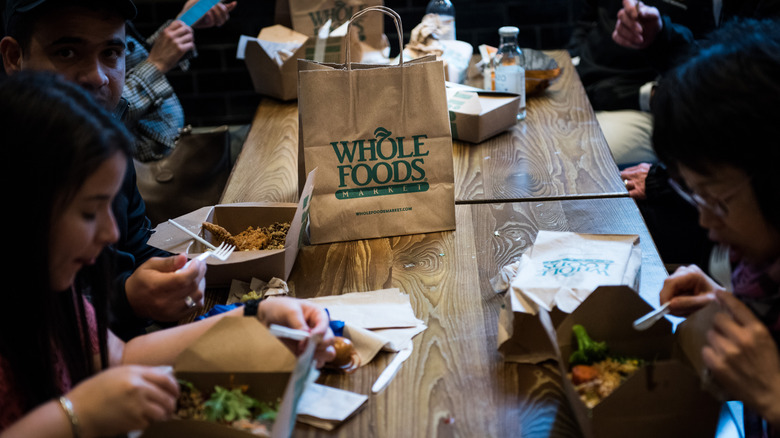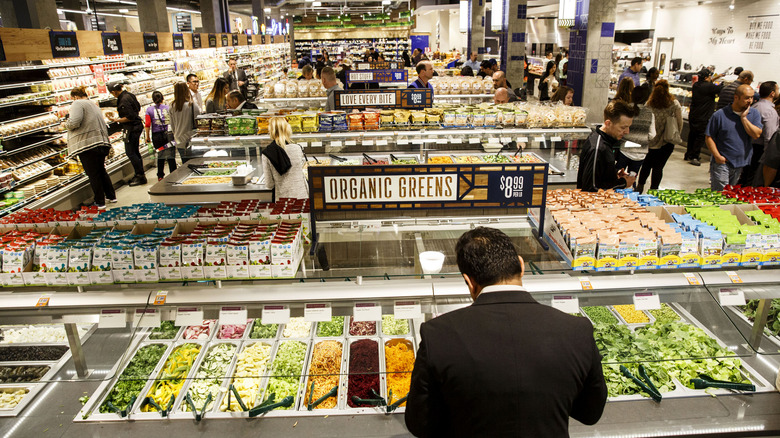If You Live In A Big City, Avoid Whole Foods At Lunch Time
Grocery shopping is a chore that many people dread due to the massive amounts of people, stressful environment, and high prices. However, some shoppers have managed to turn their grocery trips into an event. Thanks to retailers like Target and Costco, shopping for weekly perishables and pantry staples can begin with a stop at the in-store Starbucks for some much-needed caffeine while strolling the aisles and end at the food court for a quick bite before loading this week's haul into the car. Popular high-end grocer Whole Foods has taken this idea one step further by offering a cafeteria full of hot foods, on-the-go bites, and a salad bar.
Still, many will agree that grocery shopping is less enjoyable as the store becomes more crowded. Suddenly, strolling through the aisles becomes a mad dash through only the more necessary areas, hoping to grab your essentials before others have cleared the shelves. Shopping at Whole Foods during the week is your best bet for shorter lines and fewer crowds. If you hope to enjoy a meal at the hot bar during your shopping trip, it's probably best to avoid the lunch rush, especially if you visit Whole Foods in a larger city. During lunchtime, the hot bar is most attractive to hungry employees of big businesses in the nearby areas who are looking for something quick and easy to eat on their lunch break.
Steer clear of the 12 to 2 p.m. rush
Whole Foods is notably crowded during the weekends when shoppers are utilizing their days off to check off things on their to-do lists and prepare for the week ahead. However, the second most crowded time to visit Whole Foods depends on your location and the time of day. Whole Foods located in big cities are densely populated during the lunch rush from noon to 2 p.m. If you are trying to optimize your shopping experience by strategically visiting during the weekday, get your shopping done before or after people visit Whole Foods on their lunch break.
If you're on the clock during this lunch window, you may want to save your Whole Foods trip for the end of your shift. Unlike the 12 to 2 p.m. swarms of hungry businesspeople, more urban Whole Foods locations are far less crowded during dinner time. Many workers want to head home right after work and will make a stop at the Whole Foods closer to home. With a majority of people commuting to the surrounding suburbs, it's no wonder that Whole Foods stores located in suburban areas are most densely populated at 5 p.m. on weekdays.
The hot bar at Whole Foods is getting seriously expensive
When you're shopping at Whole Foods, you may want to avoid the hot bar and prepared foods sections altogether. Not only will it be extra crowded each weekday during the lunch rush, but even when crowds are small, prices are high. The enticing scents of hot soup, cold cuts, and prepackaged goodies are enough to distract even the most disciplined of shoppers. If you give in and visit the hot bar, expect to pay a heavy price.
Whole Foods has long maintained a reputation for being one of the most expensive grocery stores — and their steady price hikes may be deterring shoppers from visiting their hot bar. Whole Foods regulates the cost of their hot bar and prepared foods based on weight per pound. While prices will vary depending on location, most shoppers can expect to pay quite a bit per pound of food. One Reddit user posted on r/wholefoods, asking if other users have noticed drastic price hikes at the hot bar in a short time, writing, "Didn't they bump the hot bar up to $10.99 a month ago? A month later, they bump it up $11.99 that quick? ... Welp, no more hot bar for me. I don't need my whole check being spent there." Another user lamented that prices increased to $13.99 in New York City locations, deciding to "definitely never [buy] hot bar again."


